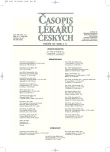-
Medical journals
- Career
Nicotinic Acid: An Unjustly Neglected Remedy
Authors: A. Žák; M. Zeman; M. Vecka; E. Tvrzická
Authors‘ workplace: IV. interní klinika 1. LF UK a VFN, Praha
Published in: Čas. Lék. čes. 2006; 145: 825-831
Category: Review Article
Overview
In human organism, the administration of nicotinic acid (niacin) leads to two types of effects. Within the physiological range (≈20 mg/day), niacin has a vitamin-like role as pellagra preventing factor. The pharmacological dosage (≈0,5-4,5 g/day) substantially influences the plasma lipid and lipoprotein concentrations: decreases VLDL and LDL concentrations, changes the profile of LDL subfractions towards the larger particles as well as particles with lower density; it also profoundly increases the concentration of HDL-C in consequence of elevated concentration of HDL2 subfraction. Niacin as the only hypolipidemic drug reduces the lipoprotein(a) concentration. The hypolipidemic mechanism of niacin is different from that of other hypolipidemic drugs. On the basis of clinically controlled trials (both interventional epidemiological and angiographical), which satisfy the criteria of evidence-based medicine, it is possible to conclude that niacin falls unambiguously into the class of hypolipidemic drugs with proven beneficial effect not only on cardiovascular mortality and morbidity, but also on total mortality. Therefore, niacin should have an indisputable role in the pharmacological control of dyslipidemias. With the respect of basic mechanism (inhibition of the lipolysis of adipose tissue) with subsequent decrease in the concentration of free fatty acids and their flux to liver, niacin fulfils the criteria for pathogenetic treatment of atherogenic dyslipidemia in metabolic syndrome. The prerequisite condition for the niacin treatment is the respect for serious adverse effects and possible health hazards of administration (skin flush, hepatotoxicity and deterioration of glucose homeostasis). Recently discovered extrahypolipidemic effects of niacin (antioxidative activity, facilitation of reverse cholesterol transport, activation of PPAR-γ, antithrombotic effects) and the introduction of drug forms with sustained (extended resp.) release of active compound (that minimizes the adverse effects and administration hazards) form together the basis for firm statement that the derivatives of nicotinic acid should be introduced to the clinical practice in Czech Republic.
Key words:
niacin, flush, deterioration of glucose homeostasis, hepatotoxicity, inhibition of lipolysis, hypolipidemic effects, changes in cardiovascular morbidity and mortality, sustained (extended resp.) release.
Labels
Addictology Allergology and clinical immunology Angiology Audiology Clinical biochemistry Dermatology & STDs Paediatric gastroenterology Paediatric surgery Paediatric cardiology Paediatric neurology Paediatric ENT Paediatric psychiatry Paediatric rheumatology Diabetology Pharmacy Vascular surgery Pain management Dental Hygienist
Article was published inJournal of Czech Physicians

-
All articles in this issue
- Nicotinic Acid: An Unjustly Neglected Remedy
- New Tobacco Dependence Pharmacotherapy: Varenicline, Parcial Agonist of α4ß2 Acetylcholin-nicotine Receptors
- Pigmented Tumors of the Skin and Anoikis
- Contemporary Non-invasive Aesthetic Medicine
- Carboxytherapy – A New Non-invasive Method in Aesthetic Medicine
- Sulcus Nervi Dorsalis Penis/Clitoridis: Clinical and Forensic Aspects
- Diagnostics and Indications of Surgical Treatment of Patients with Lung Carcinoma at the First Clinic of TRN of the First Faculty of Medicine and the VFN Prague in Years 2004 to 2005
- Molecular Genetic Characterization of Chronic Lymphocytic Leukemia Aggressivity in Czech Patients: A Nucleotide Variability of Genes Coding for Heavy Chain of Immunoglobulin
- Adiponectin and Insulin Sensitivity
- Multidisciplinary Use of Contrast Sensitivity
- Mean Platelet Volume (MPV) in Crohn’s Disease Patients
- Colorectal Cancer – Short Time Results of Laparoscopic Resection in 350 Patients
- Our First Experience with CT Enteroclysis
- Comments to Statistical Methods in Medical Disciplines
- Journal of Czech Physicians
- Journal archive
- Current issue
- Online only
- About the journal
Most read in this issue- Nicotinic Acid: An Unjustly Neglected Remedy
- Mean Platelet Volume (MPV) in Crohn’s Disease Patients
- Our First Experience with CT Enteroclysis
- Contemporary Non-invasive Aesthetic Medicine
Login#ADS_BOTTOM_SCRIPTS#Forgotten passwordEnter the email address that you registered with. We will send you instructions on how to set a new password.
- Career

